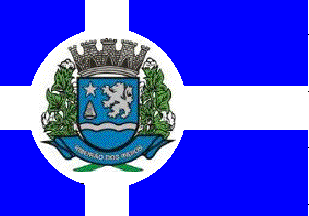 image
by Ivan Sache, 1 March 2013
image
by Ivan Sache, 1 March 2013
Last modified: 2013-03-23 by ian macdonald
Keywords: sao paulo | ribeirão dos Índios |
Links: FOTW homepage |
search |
disclaimer and copyright |
write us |
mirrors
 image
by Ivan Sache, 1 March 2013
image
by Ivan Sache, 1 March 2013
Ribeirão dos Índios was established in 1922 by Antônio Feitor on a
plot sold by Colonel João Gomes Martins (1887-1937), a Portuguese
colonist born in Madeira. Feitor was jointed two years later by more
colonists, mostly of Italian origin. A settlement was established in
1925 close to the Indians' River (Ribeirão dos Índios). The district
of Ribeirão dos Índios was established by Municipal Law 2,793 of 26
December 1936, as part of the municipality of Santo Anastácio.
The municipality of Ribeirão dos Índios was established by State Law
No. 9,330 of 27 December 1995.
http://www.ribeiraodosindios.sp.gov.br - Municipal website
The symbols of Ribeirão dos Índios were designed by Lauro Ribeiro Escobar.
The flag is blue with an off-centered white cross. Over the intersection of the cross' arms is placed a white disk charged with the municipal coat of arms. The cross, as the symbol of faith, and the disk, as the symbol of eternity, highlights the Christian faith of people and their aspiration to keep forever the obtained emancipation.
http://camarapprudente.sp.gov.br/historia/hist_oeste/cidades/rindios/simbolos.html - "Enciclopédia Digital de Oeste Paulista" website
Photo of the flag
http://www.ribeiraodosindios.sp.gov.br/noticia.php?noticia=90
The coat of arms is "An Iberic shield, azure dexter a bell ensigned with a star sinister a lion rampant in base a fess wavy all argent. The shield surmounted by an eight-towered mural crown argent ports sable. The shield supported by two branches of cotton proper. Beneath the shield a scroll azure charged with the municipality's name in letters argent."
The Iberian shield, used in Portugal at the time of discovery of Brazil, evokes the first colonizers and builders of Brazil. Azure is a symbol of justice, beauty, sweetness, nobleness,, vigilance, serenity, constancy, incorruptible firmness, dignity, zeal and loyalty. The bell represents the birth of Jesus and alludes to one of the most cherished folkloric traditions of the town, the Folia de Reis [a festival of Portuguese origin, dedicated to the visit of the Three King Magi to Baby Jesus]. The bell is also a symbol of fame. The star is reference to the Star of Bethlehem. The star is a symbol of bright future, light through the night, aspiration to highness and safe guidance. The lion, as the most noble animal in heraldry, is a symbol of force, greatness, courage, magnanimity and vigilance, recalling the courage of the early colonists, who built on their own resources the first road linking the village to Santo Anastácio, then the seat of the municipality. The fess wavy represents the water resources and make the arms canting, recalling the river ("ribeirão") for which the municipality is named. Argent is a symbol of felicity, purity, temperance, truth, frankness, equity, integrity and friendship. The mural crown is a symbol of municipal emancipation; the open ports are a symbol of hospitality. The branches of cotton highlight the fertility of the generous soil, cotton being a main source of income for the municipality.
http://camarapprudente.sp.gov.br/historia/hist_oeste/cidades/rindios/simbolos.html - "Enciclopédia Digital de Oeste Paulista" website